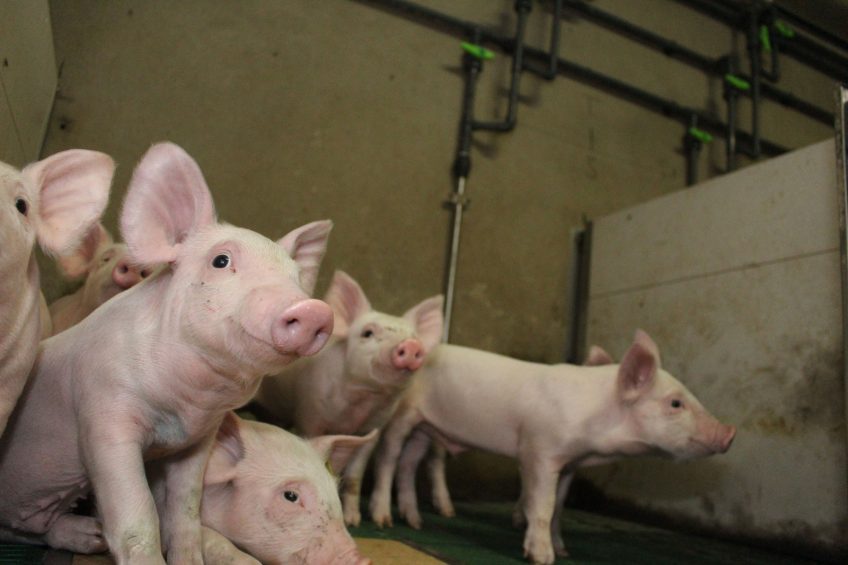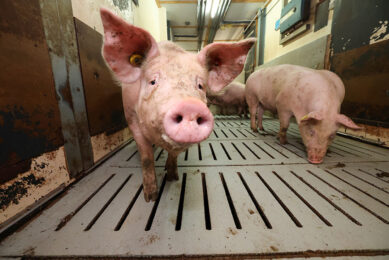Farm producing pigs, data and knowledge

Gathering data, data and more data – that is what matters at the Swine Research Farm north of Segovia, Spain. Not surprisingly, the farm is full of sensors as well as innovative ideas to uncover pig knowledge yet to be discovered.
Farm manager Miguel Ángel Tejedor kneels in front of what looks like a fridge. On top is a bed of sunflower seeds. With his hands he presses on the top floor of the white case and reveals the true nature of this innocent-looking white box: a rat trap, with a rooftop that can flip over. He moves the box’s entire top part away; its contents are a basin, filled with a mixture of water and alcohol. In this no rat survives longer than a few minutes, he says.
The model Tejedor shows is for demonstration purposes – hence a human smell is not a problem. The real ones are hanging at various places inside the research farm. Initially, the number of caught rats easily went up to 70 per month. Rats usually warn each other of dangerous situations, he says, but that’s not possible when bathing in alcohol. The monthly catch is now about three or four.
Innovative ideas
It’s this kind of innovative ideas that is exemplary for the Swine Research Farm (Centro Experimental Porcino, CEP), near Aguilafuente, at about 40 km north of Segovia, Spain. The farm is a separate entity, but is closely connected to pig research, service and consultancy company PigChamp Pro Europa. Every innovation is welcomed, as long as it supports the key function, to acquire the best data possible.

Centro Experimental Porcino.
In fact, it’s hard to think of things that aren’t recorded. The farm’s mission is to continuously search for quantifiable statistical data, loads of them, the more that can be monitored, the more that can be analysed and benchmarked, the better it is.
The majority of research trials revolve around feeding, environment and welfare, explains Carlos Piñeiro, director at PigChamp Pro Europa. Personally, he is the main shareholder of the farm and a strong believer that the Web and Big Data are going to help livestock production and agriculture push forward, becoming more professional. A great example of this philosophy is the ongoing gathering of sow feeding data to eventually be able to use these figures for predicting which sows might abort or will deliver a higher number of stillborn piglets, by means of cognitive analytics.
International as well as major Spanish health and animal nutrition companies make use of the farm’s services, from Elanco to Zoetis and from Chr. Hansen to Zinpro. Most compound feed diets are made specifically for these trials by feed company Nuri i Espadaler, from Vic near Barcelona, Spain.
Swine Research Farm (CEP), Segovia, Spain
The CEP near Aguilafuente, 40 km north of Segovia, Spain, has 500 sows. The farm is in transition to use only Danbred gilts (Large White x Landrace) to be served with Bavarian Piétrain semen. The farm weans between 27-28 piglets/sow/year and gets compensated in case retarded growth or premature deaths occur as a result of the trials. Male piglets are not castrated; the farm runs at a three-week system with weaning at 28 days. All pigs are vaccinated for PCV2, PRRS and M. hyo. Antibiotics are only used by prescription for individual animals.
Farm set-up
The 500-sow research farm consists of two parts – an older two-barn section which was acquired in 2004 and a newer pig barn which was added only in 2015.
The older section initially was a commercial farm. Piñeiro explains, “We had to adjust the older farm buildings at certain places to make it suitable for research. Initially, for instance, they had placed Electronic Sow Feeding (ESF) stations with the entrance close to the wall. The result was that one dominant sow was blocking the entrance and wouldn’t go. That wasn’t very handy. When we installed new ESF stations, we turned that around. Things have worked a lot better ever since.”
Purpose-built research barn
The newer part of the farm was added in 2015 for about €320,000 and was completely purpose-built for being a research facility. Interesting in this addition is the opportunity to do intensive environmental research, as a rather costly infrared photoacoustic field gas monitor is connected to each of the five rooms inside this barn. The device can measure ammonia, methane, nitrous oxide or CO2.
Piñeiro: “Quite often, clients would like to know not only the effect of certain feed additives on growth performance, but also the output on the environment. Is most of the feed converted into growth or is also a part influencing air quality? That is why we have several sensors in every room, they measure at any wished moment the exact composition of the air and also measure the air flow, to determine the mass of pollutants emitted per place and year as international standards demand.”
In one of the rooms, eight purpose-built ‘metabolic cages’ can be found – elevated individual sow stalls. The pens come with drawers underneath so that any faeces and urine can be collected and analysed immediately, e.g. in digestibility or pharmacokinetics studies. An extension is possible to accommodate piglets as well. Sows don’t stay in here very long, Piñeiro adds, at the most a few days. At the moment of the visit, it didn’t have any occupants.
One of the first trials having taken place in these metabolic cages was a research in cooperation with the Spanish National Research Council (CSIC), to identify the effects of dietary betaine and conjugated linoleic acid on growers and finishers.
A small part of the farm’s piglets (roughly 1,000 per year) will be moved to one of the new building’s five grow-finisher rooms. This allows the CEP to observe long-term effects of certain feeding trials in sows on their progeny until about 150-160 days. One of these rooms is equipped with four Nedap’s Pig Performance Testers, devices which can individually measure feed intake, body weight and feed efficiency using ear tags, up to 16 pigs in every one of them. In the other three sections, feeding is done manually from bags, which is also measured. A surgery-necropsy room completes this farm building.
Spain’s pig production is doing well
Although Spain has been fighting very bad economic conditions, the country’s pig industry appears to be thriving like never before. In 2015, Spain even overtook Germany as being the country with the most pigs in the European Union, with a total of over 28 million pigs. Pork exports to e.g. France have been booming lately, where the pig industry is in a more deplorable state. The reason for Spain’s success is dependent on various factors, says Carlos Piñeiro, director at PigChamp Pro Europa. He explains, “Firstly, wages are relatively low in Spain, so we have low costs of production. This way we manage even when the pig prices are relatively low. Also, we have space – the region of Castilla-León for instance is one of the least densely populated areas in the EU, so there’s no complaining neighbours, despite respecting all environmental EU regulations. Thirdly, we had a major shake-up of our pig industry in the 1990s, which made the country very professional and having the right attitude. About two-thirds of the country’s pig industry nowadays is in the hands of large conglomerates or integrations. They can deal with a temporary financial setback.”
The 2004 section
The initial farm complex, acquired in 2004 for around €900,000, consists of two barns. It is in use for dry and lactating sows and runs as a regular commercial farm in case no trials are performed. In practice, however, ongoing trials are being done, and everywhere through the buildings sensors can be spotted to measure e.g. climate, ventilation, feed intake and water usage. On-site, for instance, a group of researchers is collecting randomised blood samples from young piglets, to identify effects of feed ingredients in serum. Another set of technical experts checks every sensor to make sure all results obtained are valid.
The dry sow building consists of two sections with crates, for insemination and the first few days in gestation, up to about a month. The remainder consists of two sections with in total four Electronic Sow Feeding (ESF) stations, with built-in weighing equipment, produced by Gerionte, a Spanish company. A sow sluice leads to the second building, with both farrowing and nursery rooms.
There are 12 lactation rooms, housing 12 sows each, in pens that are slightly larger than conventional.
In addition, there are seven nursery rooms, with 24 pens each for roughly five to eight pigs. About 13,000 piglets/year stay here until a weight of around 20-25 kg (60-70 days), after which they are sold to commercial farms. The amount of 24 pens is not chosen by accident. Piñeiro explains, “This way we can do trials in whichever amounts that are desired. We can create 12 groups of two, eight of three, six of four etcetera.”
Four rooms are equipped with four different water supply lines leading to the pens. This is a way to test several liquid solutions to the pigs, explains Piñeiro, but it also helps to learn about piglet water intake as well. Piñeiro says, “Things are not happening as you might expect. What we see is that straight after weaning, piglets not only have to learn how to eat, they also have to learn how to drink from a nipple! And once they drink, there’s not a steady flow either. They usually start drinking in the morning until they are completely full and then leave the drinker again.”
Tangible trial results at the CEP
Examples of research outcomes done at the CEP in Segovia include various published results. Together with Animine, at the CEP trials were done on organic ZnO at very low doses to control diarrhoea. With Evonik, work was done on amino acid ratios. With Zinpro, the farm did trials on adjusted microminerals doses for grow-finishers and piglets to increase vitality and robustness, with Elanco on birthweight and survivability. In addition, practical work was carried out on gilt progeny segregation, improving health and decreasing antibiotics. In addition, for the Spanish Ministry of Agriculture, Food and Environment (Magrama), some housing and nutrition techniques were tested to control pollutant emissions using Best Available Techniques.
Animal health
As the example with the rats already showed, health and biosecurity do take an important place at the research farm. This is reinforced by the presence of a fence, a strict and separate showering regime before entering either section of the farm as well as a complete change of clothes. As a result, the newer farm building is completely PRRS-free.
From a research perspective, however, animal health is not the main focus of research. Piñeiro says, “I could think of two occasions in which animal health plays a role,” he says. “Firstly, we could serve as a control location in a wider trial. Secondly, it does happen that E. coli is found on the farm. In those rare occasions we just look at it as an opportunity and use it to figure out how infected piglets react to certain therapies.”















